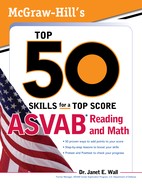Skill 4
Focus on Facts and Details
On the ASVAB, you will be asked to find factual details in reading passages. Your best bet for these questions is first to read the question to see what fact or detail is required, and then to read the paragraph to find the answer to the question. You can look for key words mentioned in the question as you read the passage. Be sure to read the entire passage. Don’t just look for the specific answer. All of the facts mentioned in the answer choices may be present in the passage, but only one will be the correct answer to the question.
As you read the passage, put your finger on the section that probably gives the answer to the question, so that you can find it again. Then after you have read the question again, go back to the part of the passage that you “fingered” as the place that has the answer so that you can double-check it.
Here is an example. Read the following paragraph and answer the questions.
Compared with the many people who consume a diet with only small amounts of fruits and vegetables, those who eat more generous amounts as part of a healthful diet are likely to have reduced risk of chronic diseases, including stroke and other cardiovascular diseases, type 2 diabetes, and cancers in certain sites (oral cavity and pharynx, larynx, lung, esophagus, stomach, and colon-rectum). Diets rich in foods containing fiber, such as fruits, vegetables, and whole grains, may reduce the risk of coronary heart disease. Diets rich in milk and milk products can reduce the risk of low bone mass throughout the life cycle. The consumption of milk products is especially important for children and adolescents who are building their peak bone mass and developing lifelong habits. Although each of these food groups may have a different relationship with disease outcomes, the adequate consumption of all food groups contributes to overall health. |
According to the passage, which foods may reduce coronary heart disease? |
|
|
|
|
By reading the question first, you know that you should be looking for a mention of coronary heart disease. You’ll find coronary heart disease mentioned in the middle of the passage in the sentence, “Diets rich in foods containing fiber, such as fruits, vegetables, and whole grains, may reduce the risk of coronary heart disease.” The sentence clearly states that fiber and whole grains are related to a reduced risk in coronary heart disease. Choice A is the correct answer.
Test Yourself!
For the same passage, try this question. Circle the letter of your choice.
![]() According to the passage, why is drinking milk important for young people?
According to the passage, why is drinking milk important for young people?
![]() It prevents cancer.
It prevents cancer.
![]() It prevents diabetes.
It prevents diabetes.
![]() It is difficult to obtain as an adult.
It is difficult to obtain as an adult.
![]() It helps build bone mass.
It helps build bone mass.
Read the following passage and answer the questions. For each question, circle the letter of your choice.
For the first time, NASA’s Hubble Space Telescope has seen distinctly the “tenth planet,” currently nicknamed “Xena,” and found that it’s only slightly larger than Pluto.
Though previous ground-based observations suggested that Xena’s diameter was about 30 percent greater than Pluto, Hubble observations, taken Dec. 9 and 10, 2005, showed Xena’s diameter as 1,490 miles. Pluto’s diameter, as measured by Hubble, is 1,422 miles.
Only a handful of images were required to determine Xena’s diameter. Located 10 billion miles from Earth with a diameter a little more than half the width of the United States, the object is 1.5 pixels across in Hubble’s view. That’s enough to make a precise size measurement.
Because Xena is smaller than previously thought, but comparatively bright, it must be one of the most reflective objects in the solar system. The only object more reflective is Enceladus, a geologically active moon of Saturn whose surface is continuously recoated with highly reflective ice by active geysers.
![]() According to the passage, which is the object that is brighter than Xena?
According to the passage, which is the object that is brighter than Xena?
![]() Hubble
Hubble
![]() Pluto
Pluto
![]() Earth
Earth
![]() Enceladus
Enceladus
![]() According to the passage, how far away is Xena from Earth?
According to the passage, how far away is Xena from Earth?
![]() 10 billion miles
10 billion miles
![]() 1.5 pixels
1.5 pixels
![]() 1,422 miles
1,422 miles
![]() 1,490 miles
1,490 miles
Read the following passage and answer the question. Circle the letter of your choice.
Six major groups make up the Brazilian population: the Portuguese, who colonized Brazil in the 16th century; Africans brought to Brazil as slaves; various other European and Middle Eastern, as well as Japanese and other Asian immigrant groups who have settled in Brazil since the mid-19th century; and indigenous peoples of Tupi and Guarani language stock. Intermarriage between the Portuguese and indigenous people or slaves was common. Although the major European ethnic stock of Brazil was originally Portuguese, subsequent waves of immigration have contributed to a diverse ethnic and cultural heritage.
![]() According to the passage, which of the following immigrant groups first arrived in Brazil in the 16th century?
According to the passage, which of the following immigrant groups first arrived in Brazil in the 16th century?
![]() Japanese
Japanese
![]() Portuguese
Portuguese
![]() Middle Easterners
Middle Easterners
![]() Indigenous people
Indigenous people
